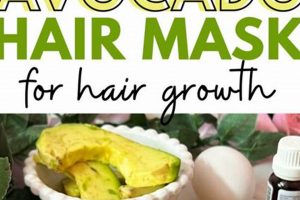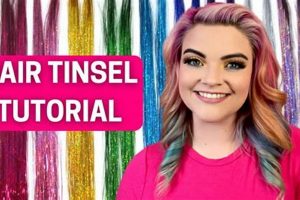The practice of attaching additional hair strands to one’s existing hair, completed without the assistance of a professional stylist, constitutes a form of personal grooming. This process encompasses various methods, including clip-ins, tape-ins, and sew-ins, all performed by the individual on themselves. For example, an individual may choose to apply temporary clip-in hair pieces to add volume for a special occasion.
The appeal of this self-directed approach lies in its potential for cost savings and the convenience of customizing hair length and volume at one’s own pace. Historically, individuals have sought means to alter their hair’s appearance, and this represents a modern iteration of that pursuit, offering greater control and accessibility than traditional salon services. The ability to independently manage these alterations contributes significantly to personal expression and confidence.
The following sections will address the various methods employed, the necessary materials and tools, best practices for application and removal, and essential considerations for maintaining the health and integrity of both the extensions and the natural hair. Further exploration will also cover potential challenges and troubleshooting tips to ensure a satisfactory outcome.
DIY Hair Extensions
Effective self-application necessitates adherence to specific techniques and precautions. The following recommendations aim to optimize the process and minimize potential adverse effects on natural hair.
Tip 1: Pre-Application Assessment: Prior to initiating the attachment process, meticulously evaluate the condition of natural hair. Weak or damaged strands are prone to breakage under the added weight. Strengthen hair through conditioning treatments weeks beforehand.
Tip 2: Precise Color Matching: Achieve a seamless blend by selecting extension shades that closely mirror natural hair color. Order color samples to compare under various lighting conditions before committing to a full purchase.
Tip 3: Sectioning and Preparation: Divide hair into clean, even sections relevant to the chosen method (e.g., horizontal rows for tape-ins, small circular sections for micro-links). Properly prepping these sections enhances adhesion and reduces tangling.
Tip 4: Secure Attachment Techniques: Employ the designated method’s recommended procedures meticulously. Over-tightening or improper placement may cause tension and subsequent hair loss. Adhere to specified spacing guidelines.
Tip 5: Gentle Detangling Practices: Utilize a wide-tooth comb designed for extensions. Commence detangling from the ends, progressively working upwards to the roots. This prevents unnecessary stress and breakage.
Tip 6: Nighttime Protection: Before sleeping, braid hair loosely or use a satin scarf/bonnet to minimize friction and prevent matting. This extends the lifespan of extensions and protects natural hair.
Tip 7: Regular Maintenance and Cleaning: Adhere to a washing schedule appropriate for the extension type. Use sulfate-free shampoos and conditioners. Thoroughly rinse all product to prevent buildup, which compromises attachment and can cause irritation.
Diligent execution of these tips contributes to a successful experience, promoting longevity and minimizing damage to underlying hair. Prioritizing hair health remains paramount throughout the process.
The subsequent section provides detailed removal strategies and long-term care advice for maintaining healthy hair both during and after use.
1. Hair type compatibility
Hair type compatibility forms a cornerstone of success in personal hair extension application. The structural characteristics of natural hair significantly influence the appropriate choice of extension type and attachment method. Failure to account for these distinctions can result in damage to the natural hair, premature extension failure, or an unnatural aesthetic. For instance, individuals with fine, delicate hair risk breakage and traction alopecia if they opt for heavy extensions or methods that exert excessive tension. Conversely, individuals with thick, coarse hair may find that lightweight extensions lack sufficient grip and are prone to slippage.
The cause-and-effect relationship between incompatibility and negative outcomes is readily observable. Improperly matched extensions frequently lead to tangling, matting, and breakage at the attachment points. Examples include the application of tape-in extensions to excessively oily hair, resulting in poor adhesion and repeated slippage, or the use of micro-link extensions on fine hair, which can cause localized hair loss due to the concentrated weight. A crucial component involves selecting extensions with similar texture and density to achieve visual blending and prevent noticeable discrepancies. Synthetic hair fibers, while cost-effective, may appear noticeably different from natural human hair, particularly when applied alongside heat styling tools.
In conclusion, understanding hair type compatibility is paramount for anyone undertaking self-application of hair extensions. Careful consideration of hair texture, density, porosity, and scalp condition is essential for selecting appropriate extension types and attachment methods. Prioritizing compatibility minimizes damage to the natural hair, maximizes the lifespan of the extensions, and achieves a more seamless and aesthetically pleasing result. The practical significance lies in the prevention of long-term damage and the assurance of a natural-looking and comfortable hairstyle.
2. Attachment Method Selection
The choice of attachment method significantly influences the success and longevity of self-applied hair extensions. The selected method dictates the application process, maintenance requirements, and potential impact on natural hair health. Careful consideration of available options is crucial for optimal outcomes.
- Clip-In Extensions
Clip-in extensions offer a temporary, non-permanent solution. They attach to the natural hair using small, pressure-sensitive clips. Suitable for occasional use and individuals seeking a quick transformation without long-term commitment. However, repeated application and removal in the same areas may cause localized hair thinning or breakage over time.
- Tape-In Extensions
Tape-in extensions utilize adhesive strips to bond the extensions to sections of natural hair. Provide a semi-permanent solution, typically lasting several weeks. Proper application requires precise alignment and secure adhesion to prevent slippage. Removal necessitates a specialized solvent to dissolve the adhesive without damaging the natural hair. Potential for residue buildup if not cleaned properly.
- Sew-In Extensions (Weaves)
Sew-in extensions involve braiding the natural hair into cornrows and then sewing the weft extensions onto the braids. Represents a more long-term solution, often lasting several months. Proper maintenance, including regular shampooing and conditioning, is vital to prevent scalp irritation and fungal growth. Removal requires carefully cutting the threads without damaging the natural hair.
- Micro-Link/Bead Extensions
Micro-link extensions attach to small sections of natural hair using tiny metal beads or links. These are clamped shut to secure the extension in place. Offer a semi-permanent option but require precise application to avoid excessive tension on the hair follicle. Improperly installed micro-links can lead to hair breakage and scalp irritation. Regular adjustments are necessary as the natural hair grows.
Each of these options presents unique advantages and disadvantages for individuals undertaking self-application. Understanding the nuances of each method, including its application process, maintenance demands, and potential risks, is paramount for achieving a successful and damage-free outcome. A thorough assessment of hair type, lifestyle, and skill level is essential when determining the most appropriate attachment method.
3. Color and Texture Matching
Color and texture matching represent critical determinants of a successful self-application of hair extensions. Discrepancies in these attributes result in an unnatural appearance, undermining the intended aesthetic enhancement. The human eye readily detects inconsistencies in color gradation or textural uniformity, leading to a perception of artificiality. This diminishes the believability of the enhanced hairstyle and detracts from the overall appearance.
The effect of improper matching extends beyond mere aesthetics. Textural mismatches can lead to differential behavior during styling. For example, extensions with a different curl pattern than the natural hair may not blend seamlessly when subjected to heat styling or humidity, creating an inconsistent look. Color discrepancies, even subtle ones, become amplified under varying lighting conditions, revealing the extensions as separate entities rather than integrated components of the hairstyle. A real-world illustration involves the application of synthetic extensions with a high sheen to natural hair with a matte finish; the stark contrast in light reflection creates an obvious distinction. The practical significance lies in the ability to achieve a cohesive and undetectable result, enhancing confidence and avoiding a self-conscious appearance.
Achieving optimal color and texture matching necessitates careful assessment and meticulous selection. Matching hair color requires considering not only the base shade but also any subtle variations, highlights, or lowlights present in the natural hair. Texture matching involves assessing the hair’s curl pattern, strand thickness, and overall density. Sourcing extensions from reputable suppliers who offer a wide range of color and texture options, along with the provision of color matching services, is crucial. Failure to prioritize these considerations compromises the outcome of hair extension application. Therefore, the pursuit of a seamless and believable result demands an unwavering focus on accurate color and texture alignment.
4. Proper Installation Technique
Proper installation technique constitutes a fundamental pillar in the successful self-application of hair extensions. The connection between technique and outcome is direct and demonstrably causal. Inadequate technique precipitates a cascade of negative consequences, ranging from visible aesthetic flaws to lasting damage to natural hair. The importance of proper installation cannot be overstated; it is the linchpin upon which the entire undertaking rests. This factor dictates the security, longevity, and appearance of the installed extensions.
Examples of inadequate technique manifesting in adverse outcomes are readily observed. For instance, improper spacing during tape-in application leads to exposed adhesive and visible gaps. Over-tightening micro-link extensions creates excessive tension on hair follicles, leading to traction alopecia. Incorrect sew-in weaving can result in uneven weight distribution, causing discomfort and potential scalp irritation. These scenarios underscore the necessity of meticulous execution. Training videos, detailed instructions, and patient practice are crucial components of mastering the appropriate techniques for each extension type. Furthermore, the use of quality tools, specifically designed for extension application, contributes significantly to precision and minimizes the risk of error.
The practical significance of understanding and adhering to proper installation protocols lies in the prevention of avoidable problems. By prioritizing technique, individuals undertaking self-application can minimize the risk of damage, maximize the lifespan of the extensions, and achieve a natural-looking and aesthetically pleasing result. While the allure of cost savings and convenience may motivate self-application, neglecting the importance of technique ultimately negates these benefits, resulting in frustration, expense, and potential harm. Therefore, diligent preparation, careful execution, and a commitment to mastering the required skills are essential prerequisites for successful self-administered hair extensions.
5. Maintenance and Removal Practices
The longevity and health of both natural hair and extensions are intrinsically linked to meticulous maintenance and removal practices within the context of self-administered hair extensions. Inadequate adherence to recommended care protocols can lead to a cascade of adverse consequences, ultimately undermining the benefits derived from the extensions. Maintenance dictates how the extensions integrate with the natural hair over time, influencing factors such as tangling, matting, and overall aesthetic appearance. Removal, if performed incorrectly, poses a significant risk of damage to the hair follicle and scalp, potentially leading to irreversible hair loss. The understanding of these interconnected factors is critical for individuals engaging in self-application.
Examples of neglecting proper maintenance practices abound. Failure to use sulfate-free shampoos can strip natural oils, causing dryness and breakage in both the extensions and the surrounding hair. Insufficient detangling results in knots and mats, necessitating forceful combing that damages the hair shaft. Improper washing techniques can lead to product buildup, causing scalp irritation and compromising the adhesive bonds of certain extension types. Similarly, improper removal techniques inflict demonstrable harm. Forcibly pulling out extensions without using appropriate solvents or tools tears the natural hair, leading to breakage at the root. Ignoring signs of tension or discomfort during wear can result in traction alopecia, a condition characterized by gradual hair loss due to prolonged strain on the follicles. These real-world illustrations underscore the critical importance of adhering to established best practices for both maintenance and removal. The choice of maintenance products should be dictated by the composition of the extensions and the natural hair’s requirements to ensure integration and preserve longevity.
In conclusion, the successful undertaking of do-it-yourself hair extensions necessitates a comprehensive understanding of maintenance and removal. These practices are not merely ancillary activities; they are integral components of the process that directly impact the health and aesthetic outcome. By investing time and effort in learning and implementing proper techniques, individuals can minimize risks, maximize the lifespan of their extensions, and safeguard the integrity of their natural hair. The practical significance of this understanding lies in the ability to achieve a desired aesthetic transformation without compromising long-term hair health and well-being. Addressing the challenges of self-application requires a commitment to diligent research, careful execution, and consistent adherence to recommended protocols, reinforcing the understanding that responsible self-care extends beyond mere application.
Frequently Asked Questions about DIY Hair Extensions
This section addresses common inquiries and misconceptions regarding self-application of hair extensions, providing clear and concise information for individuals considering this endeavor.
Question 1: What qualifications are necessary to perform self-application of hair extensions effectively?
No formal qualifications exist; however, a thorough understanding of hair anatomy, extension types, and application techniques is essential. Individuals lacking prior experience should consult instructional resources and practice on mannequin heads before attempting application on their own hair.
Question 2: Are all hair extension types suitable for every individual?
No. Compatibility depends on factors such as hair texture, density, scalp sensitivity, and lifestyle. Improper selection can lead to damage or discomfort. Consulting with a professional stylist for a personalized assessment is recommended, even if self-application is intended.
Question 3: How frequently should self-applied hair extensions be removed and reinstalled?
The appropriate removal frequency varies based on the extension type and growth rate of the natural hair. Tape-ins and micro-links generally require repositioning every 6-8 weeks, while sew-ins may last up to 12 weeks. Exceeding these timeframes can result in matting, tangling, and potential hair damage.
Question 4: What are the potential risks associated with DIY hair extensions?
Potential risks include traction alopecia (hair loss due to excessive tension), scalp irritation, allergic reactions to adhesives or metals, and breakage of natural hair due to improper installation or removal. Diligence and adherence to best practices are crucial to mitigate these risks.
Question 5: Can self-applied hair extensions damage natural hair permanently?
Yes, improper installation, maintenance, or removal can lead to permanent hair loss and scalp damage. Traction alopecia, in particular, can result in irreversible follicle damage. Therefore, caution and thorough preparation are paramount.
Question 6: Is it possible to achieve salon-quality results with DIY hair extensions?
While achieving professional-level results is possible, it requires significant dedication, skill, and attention to detail. It also necessitates access to high-quality extensions, proper tools, and a comprehensive understanding of hair styling techniques. Managing expectations is essential.
In summary, DIY hair extensions present both opportunities and challenges. Successful outcomes depend on diligent preparation, careful execution, and a commitment to responsible hair care practices.
The subsequent section presents troubleshooting tips to address common issues encountered during the self-application process.
DIY Hair Extensions
This exploration of the realm of diy hair extensions has illuminated both the potential benefits and inherent risks associated with this practice. From understanding hair type compatibility to mastering proper installation and maintenance techniques, individuals must recognize the multifaceted nature of achieving satisfactory results without professional assistance. Emphasis has been placed on the critical importance of informed decision-making, meticulous execution, and a commitment to safeguarding the health and integrity of natural hair.
The decision to undertake self-application warrants careful consideration, weighing the potential for cost savings and convenience against the risk of damage and unsatisfactory aesthetic outcomes. Individuals are encouraged to prioritize thorough research, diligent practice, and responsible hair care practices. Further advancement in materials and methods may mitigate some inherent risks; however, the ultimate responsibility for successful implementation remains with the individual.







